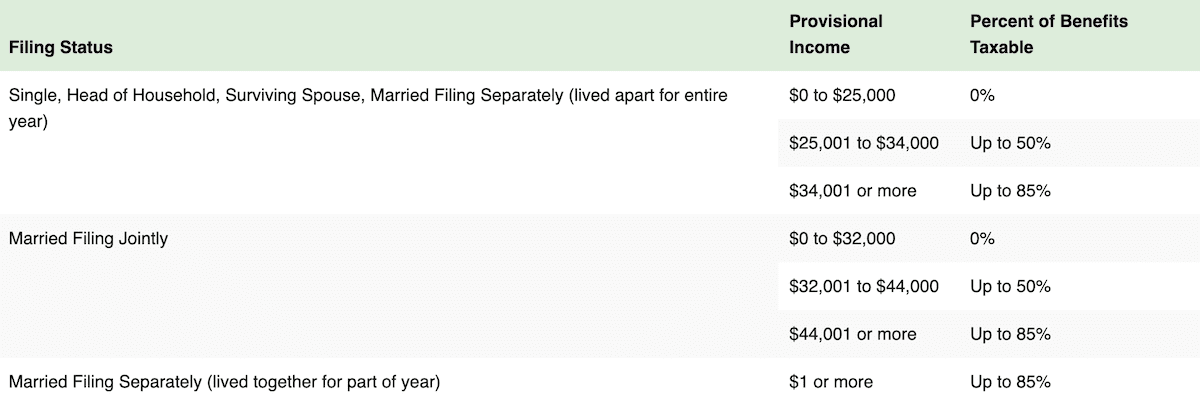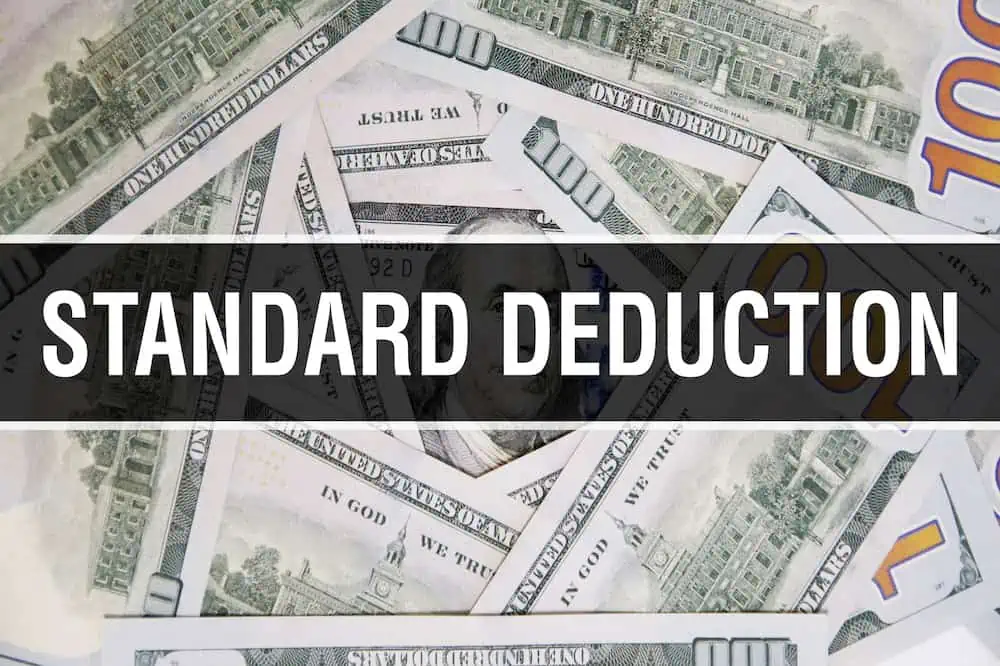“Will I have to pay taxes on my Social Security benefits?” That is a very common question that looms large for many seniors and individuals nearing retirement. The answer, though, is not so straightforward, as your circumstance will largely dictate the answer.
Generally speaking, retirees relying solely on Social Security for income often don’t have to worry about federal taxes on these benefits. However, if you have other sources of taxable income, such as wages, pensions, withdrawals from traditional IRAs or 401(k)s, or earnings from rental properties, expect to pay taxes on a portion of your Social Security income.
But determining how much of your Social Security benefits are subject to federal taxes is not always easy. You need to run through some calculations to figure that out.
Fortunately, there’s some good news for everyone: At least some of your Social Security benefits will not be taxed. At a minimum, 15% of your benefits will be exempt, which is more than you can say for most other common forms of retirement income.
Read on to see how you’ll fare when it comes to taxes on Social Security benefits. I’ll show you how to determine whether any of your Social Security benefits are taxable, calculate and report the tax if they are, pay taxes on benefits up front, and more!
Table of Contents
Are Social Security Benefits Taxable?

Generally, Social Security income is taxable. This is true whether you’re receiving monthly retirement, survivor, or disability benefits from the Social Security Administration. Tier 1 railroad retirement benefits count as Social Security income and are generally taxable benefits, too.
However, you don’t have to pay federal income taxes on Social Security payments if your combined income is below a certain amount. In addition, Supplemental Security Income (SSI) payments, which are sent to qualified people with a limited total income, aren’t taxable. Disability payments received for injuries incurred as a direct result of a terrorist attack against the U.S. or its allies aren’t taxable, either. This includes Social Security Disability Insurance (SSDI) payments.
Are Your Social Security Benefits Taxable?

The first step in determining if your Social Security benefits are taxable is to calculate what’s commonly called your “provisional income” (a.k.a., combined income).
For most seniors, your provisional income is equal to the combined total of 50% of your Social Security benefits, modified adjusted gross income, and tax-exempt interest. If you’re filing a joint return, include amounts for both spouses.
— 50% of Social Security Benefits + Modified Adjusted Gross Income (MAGI) + Tax-Exempt Interest = Provisional Income
If your provisional income is low enough, none of your Social Security benefits will be taxed (i.e., 0%). However, this generally isn’t the case if you have taxable income in addition to your Social Security benefits (e.g., taxable distributions from a traditional IRA or pension).
If your provisional income is above the 0% threshold, then up to 50% or up to 85% of your Social Security benefits will be subject to federal income tax.
In all cases, the provisional income thresholds are based on your filing status.
Calculating Provisional Income: Half of Social Security Benefits

When figuring 50% of your Social Security benefits, use the amount listed in Box 5 from each Social Security benefit statement (Form SSA-1099) you receive. (You should receive Form RRB-1099 if you receive railroad retirement benefits treated as Social Security.)
If you receive a lump-sum benefit payment for the current tax year and/or a previous year, include the full amount when calculating your Social Security benefits.
A couple’s Social Security benefits should also be combined if a joint return is filed.
Related: Don’t Believe These 17 Social Security Myths
Calculating Provisional Income: Modified Adjusted Gross Income

For purposes of determining whether you must pay tax on your Social Security income, modified adjusted gross income means the adjusted gross income reported on your federal income tax return (Line 11 on your 2023 return), minus any tax deduction or exclusion for:
— Employer-provided adoption benefits
— Foreign earned income or housing
— Income earned by residents of American Samoa or Puerto Rico
If you’re claiming an exclusion of interest from Series EE and I U.S. savings bonds issued after 1989, don’t use the amount from Line 2b of Form 1040 when calculating your modified adjusted gross income. Use the amount from Line 2 of Schedule B (Form 1040) instead.
Related: 11 Ways to Avoid Taxes on Social Security Benefits
Calculating Provisional Income: Tax-Exempt Interest

Nontaxable interest is reported on Line 2a of your federal return (Form 1040). This includes interest on municipal bonds. Tax-exempt interest is generally reported in Box 8 of Form 1099-INT, although certain types of exempt interest could be reported on other forms you receive, such as Form 1099-OID (for tax-exempt original issue discount) or Form 1099-DIV (for tax-exempt interest dividends from a mutual fund).
Related: Best Schwab Retirement Funds for a 401(k) Plan
If You Still Need Help Determining How Much of Your Social Security Income is Taxable

The instructions for Form 1040 and IRS Publication 915 have worksheets to help you determine how much of your Social Security income is considered taxable income. The Internal Revenue Service (IRS) also has an online tool to help you run through the calculations.
Related: Best Fidelity Retirement Funds for a 401(k) Plan
0% of Social Security Benefits Subject to Tax

You don’t have to pay federal income taxes on any of your Social Security benefits if either:
— Your filing status is single, head of household, or surviving spouse, and your provisional income is $25,000 or less
— You’re married and filing a joint return, and your provisional income is $32,000 or less
— You’re married and filing a separate return, you lived apart from your spouse for the entire year, and your provisional income is $25,000 or less
Related: What’s Your Capital Gains Tax Rate?
Up to 50% of Social Security Benefits Subject to Tax

You’ll pay tax on up to 50% of your Social Security benefits if either:
— Your filing status is single, head of household, or surviving spouse, and your provisional income is between $25,001 and $34,000
— You’re married and filing a joint return, and your provisional income is between $32,001 and $44,000
— You’re married and filing a separate return, you lived apart from your spouse for the entire year, and your provisional income is between $25,001 and $34,000
Up to 85% of Social Security Benefits Subject to Tax

You’ll pay tax on up to 85% of your Social Security benefits if either:
— Your filing status is single, head of household, or surviving spouse, and your provisional income is more than $34,000
— You’re married and filing a joint return, and your provisional income is more than $44,000
— You’re married and filing a separate return, you lived apart from your spouse for the entire year, and your provisional income is more than $34,000
— You’re married and filing a separate return, and you lived with your spouse for any part of the year (regardless of your provisional income)
Related: Capital Gains Tax: What Is It, Rates, Home Sales + More
Summary of How Much of Your Social Security Benefits Are Subject to Taxation

Above, we provide a summary table of how much of your Social Security benefits are subject to taxation.
Related: Best Vanguard Retirement Funds for a 401(k) Plan
Lump-Sum Social Security Payments

As noted earlier, you must include any lump-sum Social Security payment for a previous tax year when calculating the combined income that makes up your provisional income. Unfortunately, though, this can increase the taxable portion of your current-year Social Security benefits.
But there’s good news if you face this situation. Special tax rules permit you to calculate the taxable portion of a lump-sum payment for a previous year separately using your income for the earlier year. This could lower your overall taxable income by reducing the portion of your Social Security benefits upon which you must pay taxes.
Related: What’s Your Capital Gains Tax Rate for 2024?
If you take this route, make sure you check the box for Line 6c on your Form 1040. No adjustment to your previous year’s tax return is required, either (e.g., don’t file an amended return). And once an election to use the special lump-sum calculation method, you can’t change your mind without the IRS’s consent.
Young and the Invested Tip: This election doesn’t apply to lump-sum death benefits paid by the Social Security Administration. You don’t have to pay taxes on those payments.
Related: Best Vanguard Retirement Funds for an IRA
Calculating Federal Tax on Your Social Security Benefits

Once you know how much of your Social Security benefits are subject to tax (as recorded on Line 6b of your Form 1040), that amount becomes part of your taxable income. As a result, the ultimate federal tax bite on your benefits depends on your tax bracket. For example, if you’re in the 22% bracket, the tax on your Social Security income won’t exceed that rate.
Don’t confuse the rates used to determine how much of your Social Security income is taxable—0%, up to 50%, or up to 85%—with the income tax rate imposed on your overall taxable income. They are different!
Of course, your tax burden will also be reduced or you won’t owe taxes at all if the standard deduction, itemized deductions, or other adjustments bring your taxable income down or reduce it to zero. Tax credits and previous tax payments can also cut your ultimate tax bill or even leave you with a tax refund.
Related: 9 Monthly Dividend Stocks for Frequent, Regular Income
Withholding Taxes From Your Social Security Benefits

Speaking of previous tax payments, you can have taxes withheld from your Social Security benefits by completing Form W-4V and sending it to your local Social Security Administration office. You select the rate at which they withhold taxes from your payments, but it must be at either a 7%, 10%, 12%, or 22% rate.
Related: 5 Best Vanguard Retirement Funds [Start Saving in 2024]
If you want to change the amount of withholding, simply submit another Form W-4V form with the new rate checked on Line 6. If you don’t want the Social Security Administration to withhold taxes any longer, complete another Form W-4V and check the box on Line 7.
Any taxes withheld during the year will be reported in Box 6 of your benefits statement (Form SSA-1099). That amount will be subtracted from your tax bill when you file your return for the year. (Tax withheld from Social Security benefits in 2023 are reported on Line 25b of your 2023 return.) So, having taxes withheld from your Social Security benefits can result in a smaller tax bill or larger refund.
Related: Retirement Plan Contribution Limits and Deadlines for 2023
In addition, because the federal income tax system operates on a “pay-as-you-go” basis (i.e., you’re supposed to pay taxes periodically throughout the year), having the government withhold taxes from your Social Security benefit payments can also help you avoid an underpayment penalty from the IRS. Generally, to avoid an underpayment penalty, you must have at least 90% of your tax liability for the year withheld, or 100% of the tax for the previous year tax (110% if your adjusted gross income for the previous year was more than $150,000). You will also dodge the penalty if your tax bill for the year is less than $1,000.
Estimated Tax Payments for Social Security Benefits

Don’t want the Social Security Administration to withhold taxes from your benefit payments? No problem! You can still avoid underpayment penalties by making quarterly estimated tax payments yourself. The same thresholds for avoiding the penalty that apply for withholding also apply for estimated payments.
Use Form 1040-ES to file and pay estimated taxes (you can also file and pay electronically through the IRS website). Worksheets in the instructions for Form 1040-ES will help you calculate the amount of each payment. Four estimated tax payments are due throughout the year, although they aren’t necessarily due every three months despite the fact that they’re often called “quarterly” payments.
Related: 13 Dividend Kings for Royally Resilient Income
State Taxes on Social Security Benefits

Just because you don’t owe taxes on Social Security benefits at the federal level, it doesn’t necessarily mean you’re spared the expense of paying taxes on your benefits at the state level. Currently, taxes on your Social Security benefits are possible in 10 states—Colorado, Connecticut, Kansas, Minnesota, Montana, New Mexico, Rhode Island, Utah, Vermont, and West Virginia.
However, the extent to which state taxes on Social Security benefits apply varies from state to state. For instance, in several states (Connecticut, New Mexico, Rhode Island, and West Virginia—to name a few), the requirement to pay taxes on your Social Security benefits kicks in only if your total income exceeds a certain level. In Colorado, paying taxes on your Social Security depends on your age. In Minnesota and Utah, Social Security benefits are generally taxable, but you may also qualify for a special tax deduction or credit to help soften the blow of having your benefits subject to state tax.
Like Young and the Invested’s content? Be sure to follow us.
Related: IRA Contribution Limits

Saving for retirement is one of the primary goals of financial planning … and IRAs are one of the most important vehicles for achieving your retirement saving goals. However, you can only put so much in IRAs each year (and the amount is subject to change on an annual basis).
Want to know how much you can stuff in an IRA this year? Check out the current IRA contribution limits before you plan your retirement savings goals for the year.
Related: 11 Ways To Avoid Paying Taxes on Your Social Security

If you’re looking to minimize the tax bite taken out of your Social Security benefits in retirement, you’ve got several available actions to reduce how much you pay each year. We outline several ways to avoid paying taxes on your Social Security benefits.
Related: What Tax Bracket Are You In?

Perhaps the best way to lower your federal income tax bill is push yourself down into a lower tax bracket to reduce your tax rate. On the flip side, you certainly want to avoid getting kicked into a higher bracket and increasing your tax rate.
But, of course, under either scenario you need to have a good feel for where you are right now. For that purpose, check out the federal tax brackets and rates that will apply for your next federal tax return.
Related: What’s Your Standard Deduction?

For most people, their largest and most important tax deduction is the standard deduction. However, the standard deduction amounts change every year to account for inflation. Plus, the standard deduction isn’t the same for everyone.
So, before start your tax return or jumping into tax planning mode, you’ll need to know how much your standard will be for the tax year.
Please Don’t Forget to Like, Follow and Comment

Did you find this article helpful? We’d love to hear your thoughts! Leave a comment with the box on the left-hand side of the screen and share your thoughts.
Also, do you want to stay up-to-date on our latest content?
1. Follow us by clicking the [+ Follow] button above,
2. Subscribe to The Weekend Tea, our weekly newsletter to read more about investing, spending, taxes, and more, and
3. Give the article a Thumbs Up on the top-left side of the screen.
4. And lastly, if you think this information would benefit your friends and family, don’t hesitate to share it with them!





